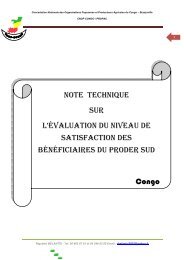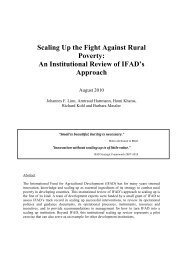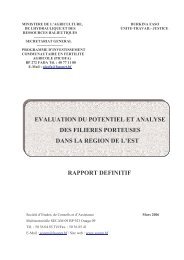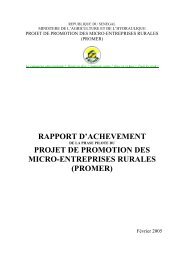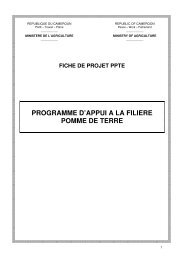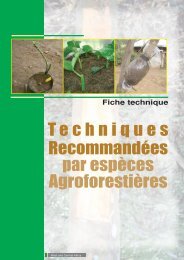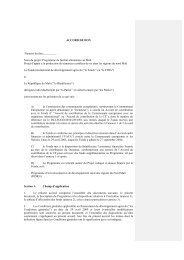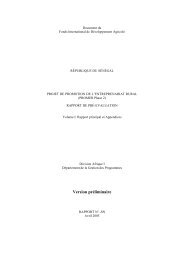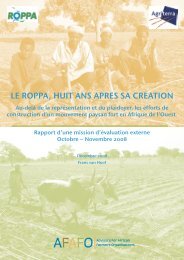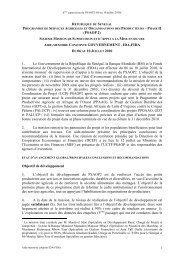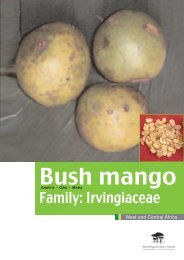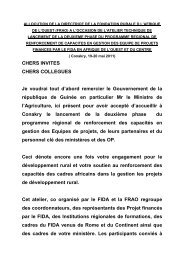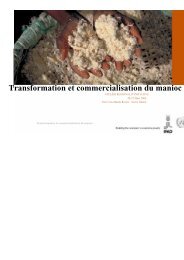CASSAVA OPPORTUNTIES IN NIGERIA - FAO.org
CASSAVA OPPORTUNTIES IN NIGERIA - FAO.org
CASSAVA OPPORTUNTIES IN NIGERIA - FAO.org
You also want an ePaper? Increase the reach of your titles
YUMPU automatically turns print PDFs into web optimized ePapers that Google loves.
unsuccessful attempts at troubleshooting, the<br />
owner was forced to close down the company.<br />
Clearly if cassava processing is to mature in<br />
Nigeria these types of deterrents must be<br />
resolved.<br />
3.2 FUTURE TARGETS<br />
A number of estimates exist as to future demands<br />
for cassava-based products. The President’s<br />
Initiative provides the following estimates.<br />
Table 3-5 Cassava Demand Estimates by President’s<br />
Initiative by 2007 (tonnes)<br />
Domestic Export Total<br />
Food 5 700 000 1 825 000 7 525 000<br />
Starch 1 770 000 3 200 000 4 970 000<br />
Livestock 15 622 000 75 621 248 91 243 248<br />
Ethanol 900 000 2 700 000 3 600 000<br />
Total 23 992 000 83 346 248 107 338 248<br />
A recent consultant’s report (Knipscheer, 2003)<br />
provides a more conservative estimate of potential<br />
domestic demand for cassava.<br />
Table 3-6 A Conservative Estimate of Demand (tonnes)<br />
Sector<br />
Current<br />
Alternative<br />
Product<br />
Use<br />
Substitution<br />
(%)<br />
Equivalent in<br />
fresh<br />
cassava<br />
roots<br />
(tonnes)<br />
Food 1 180 000 20 1 000 000<br />
Starch 67 100 100 350 000<br />
Livestock 1 200 000 20 1 000 000<br />
Ethanol 20 900 100 2 000 000<br />
Total 4 500 000<br />
For this study, these estimates have been merged<br />
with some additional assumptions to generate the<br />
following estimates of potential near term demand<br />
for cassava.<br />
13<br />
Table 3-7 Middle of the Road’ Estimate of Potential<br />
Demand for Cassava (tonnes)<br />
Sector Potential Market<br />
Food for Urban Market 14 157 438<br />
Food for Rural Market 4 378 788<br />
Food for Export 1 825 000<br />
Food as Flour 1 170 055<br />
Livestock 675 000<br />
Starch 335 000<br />
Ethanol 139 347<br />
Total 22 680 628<br />
The demand estimate in this study, different from<br />
the previous estimates, suggests that the human<br />
food market provides the greatest growth<br />
opportunity for cassava. The previous estimates<br />
suggested livestock and ethanol as the largest<br />
immediate markets. The explanation of human<br />
demand in this study’s estimate is the more than 4<br />
percent annual growth rate in urban population in<br />
Nigeria. This means that in a five-year period<br />
nearly 13 million people are expected to move to<br />
urban areas.<br />
It has been shown that these people continue to<br />
desire and eat cassava products. The difference<br />
between the urban dweller and the rural dweller is<br />
the tendency to develop preferences for foods that<br />
are convenient, well preserved and well<br />
packaged. These changes in preferences point to<br />
additional value addition to cassava products sold<br />
in urban areas.<br />
Markets for modified and new products are likely<br />
to develop. The estimates of potential growth of<br />
Nigerian urban and rural demand are based on<br />
population growth numbers and the maintenance<br />
of average per capita consumption rates. As is<br />
seen from Map 3-1 urban population is<br />
concentrated along Nigeria’s expressways. This<br />
relative concentration and access to better<br />
transportation should be beneficial to promoting<br />
the consumption of cassava and cassava<br />
products.



